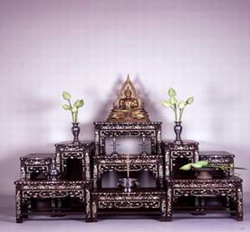Cultures of the Southeast Asia - Shows of the Philippines, Vietnam, Thailand, and Indonesia

New migrants from South East Asia, through work or marriage, are increasing. Along with their migration, they bring the lifestyles and elements of cultures into Taiwan, and such new elements bring the society new stimulation and initiate a new kind of transformation. As an initiation to understand the new cultures and promote ethnic fusion, the National Museum of History especially organized the Cultures of the Southeast Asia - Shows of the Philippines, Vietnam, Thailand, and Indonesia, which will be opened to the public at the first floor exhibition hall of the museum from October 12th to December 12th 2007.
This exhibition is an inter-museum venture. Collections from National Museums of the Philippines, Thailand, and Vietnam are on loan to the national Museum of History; plus the original collection of the Museum of History, this exhibition will showcase a total of 260 pieces, canvassing a wide range of categories, including food, fashion, accommodation, transportation, performing arts, and believes. Manila National Museum offers characteristic weaving arts of the Philippine Islands, religious carvings, and artifacts of daily living. The Ho Chi Minh City National Museum of History provides farming tools, delicate living wares, and religious statues. The Thailand National Museum provides exquisite furniture and weaving arts as well as Buddhism artifacts. The national Museum of History of Taiwan also has on exhibition a range of exquisite collections of Indonesian artifacts, including dance masks, puppets, and special weaving arts.
To attract the new migrants and their children to the shows, National Museum of History is offering free entrance for groups of three and more of the new migrant ethnics. This exhibition aims to showcase the unique cultures of the Southeast Asian countries and bring the residents of Taiwan into deeper and informed understanding of the cultures of the "New Migrants".
Representative Artifacts of the Four Cultures
(The Philippines)

Manunggul jar (replica)
This reburial clay urn is one of the national treasures of the Philippines. It is excavated From the Manunggul caves. The cover of this piece is decorated with images simulation of two persons in a boat, which symbolizes souls sailing to the future life in the boat of death. The figure at the rear holds an oar and the figure in front has his hands crossed at his chest. This is a burial posture commonly seen in the Philippines and South East Asia. The boat carrying the figures is shaped with the features of a face including the eyes, nose, and mouth. The design is still seen in the traditional boats of Northern Sarawak of Malaysia and the carving techniques are highly similar to the contemporary carvings seen in Taiwan, the Philippines, and Southeast Asia.
(Thailand)

Set of tables for installing the Buddha image
The highest seat in the center is used to place the Buddha statue. This shrine is designed in two layers; one high and one low for candle sticks and incense burners. The two lower steps by the sides are perfect for a pair of armrests or vases. The lowest steps can be used to put another pair of armrests or other objects. The left and right bottom tables are places for holy water bottles and serving trays. Overall, the primary and secondary positions are very clearly laid out.
(Vietnam)

Incense burner
Bronze - this incense burner, generally served on top of a shrine table, is composed of three parts-the cover, the burner, and the seat. The twists of bamboo nodes are ingeniously shaped to form the frame and the handles. Ingenuity is seen in the simple design.
(Indonesia)

Bark cloth blouse
This Bark-Cloth Blouse was recovered from the central region of Sulawesi. It is woven from the fiber of Paper Mulberry. Such color-painted bark-cloth blouse is usually made long sleeves and the colors are usually natural dyes from the surrounding area. It is most often worn in major life events like weddings and funerals. The intricate geometrical design is best characterized by the Buffalo horns, which symbolizes harvest. Such patterns have also been seen in male clothing and home decoration.